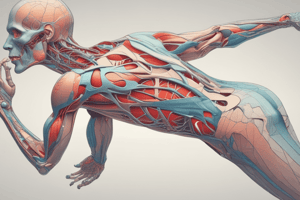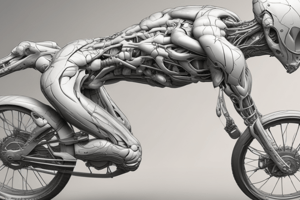Podcast
Questions and Answers
What is the location of the center of gravity in a standing position?
What is the location of the center of gravity in a standing position?
- Anterior to the S2 vertebra (correct)
- On the S2 vertebra
- Posterior to the S2 vertebra
- Above the S2 vertebra
What is balance in the context of biomechanics?
What is balance in the context of biomechanics?
- The ability to walk in a straight line
- The ability to change posture quickly
- The ability to lift heavy weights
- The ability to maintain the line of gravity within the base of support with minimal postural sway (correct)
Which of the following improves balance?
Which of the following improves balance?
- Shorter distance between the line of gravity and the border of the base of Support
- Wider base of Support (correct)
- Higher center of gravity
- Narrower base of support
What is the difference between dynamic and static posture?
What is the difference between dynamic and static posture?
What characterizes poor posture?
What characterizes poor posture?
What is the relationship between line of gravity and base of support in balance?
What is the relationship between line of gravity and base of support in balance?
What opposes the gravity moment in the thoracic region?
What opposes the gravity moment in the thoracic region?
What is the purpose of muscle torque in maintaining postural control?
What is the purpose of muscle torque in maintaining postural control?
What happens to muscle torque when there is an external perturbation?
What happens to muscle torque when there is an external perturbation?
How do you identify muscle groups activation in static postural control?
How do you identify muscle groups activation in static postural control?
What type of control is involved in predicting the effect of a voluntary movement on the body?
What type of control is involved in predicting the effect of a voluntary movement on the body?
What is the result of all muscle groups around a specific joint suddenly relaxing?
What is the result of all muscle groups around a specific joint suddenly relaxing?
What is the purpose of feedback control in postural control mechanisms?
What is the purpose of feedback control in postural control mechanisms?
What change in muscle torque would occur in the body to maintain the spine posture when performing arm flexion while standing?
What change in muscle torque would occur in the body to maintain the spine posture when performing arm flexion while standing?
What is the main function of the postural control system?
What is the main function of the postural control system?
What is the line of gravity in standing posture?
What is the line of gravity in standing posture?
What is the role of the ankle in standing posture?
What is the role of the ankle in standing posture?
What is postural sway?
What is postural sway?
What is the role of the somatosensory system in standing posture?
What is the role of the somatosensory system in standing posture?
What happens when the line of gravity falls close to the joints' axis?
What happens when the line of gravity falls close to the joints' axis?
What is the role of the central nervous system in standing posture?
What is the role of the central nervous system in standing posture?
What is the primary function of the muscle torques in standing posture?
What is the primary function of the muscle torques in standing posture?
Flashcards are hidden until you start studying
Study Notes
Postural Control Mechanisms
- There are different postural control mechanisms for different parts of the spine:
- Hip: ligaments vs extension gravitational moment
- Lumbar: ligaments vs extension gravitational moment
- Thoracic: ligaments + extensors vs flexion gravitational moment
- Cervical: ligaments vs extension gravitational moment
Muscle Torque
- Muscle torque has continuous variations to control balance (sway)
- It increases to maintain postural control in case of external perturbances
Identifying Muscle Groups Activation
- To identify muscle groups activation, consider:
- Base of Support
- Line of gravity
- Gravitational moment: opposing muscle activations
- Imagine what movement would occur if all muscle groups around a specific joint suddenly relax
Postural Control Mechanisms
- Sensorimotor control under load perturbances involves:
- Feedback control: stimulation of a corrective response after sensory detection
- Feedforward control: CNS predicts the effect of a voluntary movement and plans a sequence of anticipatory muscle activity
Balance and Posture
- Center of Mass/Gravity (COG) location changes constantly and is anterior to the S2 vertebra in standing position
- Line of Gravity is important for balance
- Base of Support is important for balance
- Centre of Pressure is important for balance
Balance
- Balance is the ability to maintain the line of gravity within the base of support with minimal postural sway
- Equilibrium is when all acting forces are cancelled by each other, resulting in a stable balanced system
- Balance improves with:
- Wider base of Support
- Lower center of gravity
- Longer distance between the line of gravity and the border of the base of Support
Posture
- Posture is the attitude assumed by the body either with support during the course of muscular activity or as a result of the coordinated action performed by a group of muscles working to maintain stability
- There are two types of posture:
- Dynamic posture
- Static posture
Standing Posture
- Standing posture involves a small base of Support and a high center of mass
- Ideal posture involves the best alignment possible, lowest muscle activity, minimal energy consumption, and high variability based on anatomy
- Poor posture leads to postural stress
External and Internal Forces
- External forces in standing posture include gravity and ground reaction forces
- Internal forces in standing posture include:
- Muscle activity
- Tensión of noncontractile structures (ligaments, capsule, bones)
Line of Gravity
- The line of gravity should be on or close to joints axis to distribute compressive forces and reduce passive tensión or muscle activation
- The plumb line is an external representation of the line of gravity and passes through:
- Mastoid process
- Cervical vertebrae
- Shoulder
- Lumbar vertebrae
- Greater trochanter
- Anterior to the knee
- Anterior to the ankle
Postural Control
- Postural control is a complex sensorimotor skill involving:
- Musculoskeletal system
- Somatosensory system (vision, vestibular, proprioception, cutaneus or tactile)
- Central nervous system integration and processing (afferent and efferent)
Postural Sway
- Postural sway is the unconscious, small movements that happen around the body's center of gravity in order to maintain balance
- Continuous muscle activation with a stabilizer role is seen in:
- Ankle
- Knee
- Hip
- Spine
Studying That Suits You
Use AI to generate personalized quizzes and flashcards to suit your learning preferences.




